engine coolant Ram ProMaster 2019 User Guide
[x] Cancel search | Manufacturer: RAM, Model Year: 2019, Model line: ProMaster, Model: Ram ProMaster 2019Pages: 332, PDF Size: 3.66 MB
Page 241 of 332

WARNING!(Continued)
do not open the hood until the radiator has had time
to cool. Never open a cooling system pressure cap
when the radiator or coolant bottle is hot.
• Keep hands, tools, clothing, and jewelry away from
the radiator cooling fan when the hood is raised. The
fan starts automatically and may start at any time,
whether the engine is running or not.
• When working near the radiator cooling fan, discon-
nect the fan motor lead or turn the ignition to the
OFF mode. The fan is temperature controlled and can
start at any time the ignition is in the ON mode.
Coolant Checks
Check the engine coolant (antifreeze) protection every 12
months (before the onset of freezing weather, where appli-
cable). If the engine coolant (antifreeze) is dirty, the system
should be drained, flushed, and refilled with fresh OAT
coolant (conforming to MS-12106) only by an authorized
dealer. Check the front of the A/C condenser for any
accumulation of bugs, leaves, etc. If dirty, clean by gently
spraying water from a garden hose vertically down the face
of the condenser.
Cooling System — Drain, Flush And Refill
NOTE: Some vehicles require special tools to add coolant
properly. Failure to fill these systems properly could lead to
severe internal engine damage. If any coolant is needed to
be added to the system please contact an authorized dealer.
If the engine coolant (antifreeze) is dirty or contains visible
sediment, have an authorized dealer clean and flush with
OAT coolant (antifreeze) (conforming to MS.90032).
Refer to the “Maintenance Plan” in this section for the
proper maintenance intervals.
Selection Of Coolant
Refer to “Fluids And Lubricants” in “Technical Specifica-
tions” for further information.
8
SERVICING AND MAINTENANCE 239
Page 242 of 332

NOTE:
•Mixing of engine coolant (antifreeze) other than speci-
fied Organic Additive Technology (OAT) engine coolant
(antifreeze), may result in engine damage and may
decrease corrosion protection. Organic Additive Tech-
nology (OAT) engine coolant is different and should not
be mixed with Hybrid Organic Additive Technology
(HOAT) engine coolant (antifreeze) or any “globally
compatible” coolant (antifreeze). If a non-OAT engine
coolant (antifreeze) is introduced into the cooling system
in an emergency, the cooling system will need to be
drained, flushed, and refilled with fresh OAT coolant
(conforming to MS.90032), by an authorized dealer as
soon as possible.
• Do not use water alone or alcohol-based engine coolant
(antifreeze) products. Do not use additional rust inhibi-
tors or antirust products, as they may not be compatible
with the radiator engine coolant and may plug the
radiator.
• This vehicle has not been designed for use with propyl-
ene glycol-based engine coolant (antifreeze). Use of
propylene glycolbased engine coolant (antifreeze) is not
recommended. •
Some vehicles require special tools to add coolant prop-
erly. Failure to fill these systems properly could lead to
severe internal engine damage. If any coolant is needed
to be added to the system please contact an authorized
dealer.
Adding Coolant
Your vehicle has been built with an improved engine
coolant (OAT coolant conforming to MS.90032) that allows
extended maintenance intervals. This engine coolant (anti-
freeze) can be used up to ten years or 150,000 miles
(240,000 km) before replacement. To prevent reducing this
extended maintenance period, it is important that you use
the same engine coolant (OAT coolant conforming to
MS.90032) throughout the life of your vehicle.
Please review these recommendations for using Organic
Additive Technology (OAT) engine coolant (antifreeze)
that meets the requirements of FCA Material Standard
MS.90032. When adding engine coolant (antifreeze):
• We recommend using Mopar Antifreeze/Coolant 10
Year/150,000 Mile (240,000 km) Formula OAT (Organic
Additive Technology) that meets the requirements of
FCA Material Standard MS.90032.
240 SERVICING AND MAINTENANCE
Page 243 of 332

•Mix a minimum solution of 50% OAT engine coolant
that meets the requirements of FCA Material Standard
MS.90032 and distilled water. Use higher concentrations
(not to exceed 70%) if temperatures below �34°F (�37°C)
are anticipated. Please contact an authorized dealer for
assistance.
• Use only high purity water such as distilled or deionized
water when mixing the water/engine coolant (anti-
freeze) solution. The use of lower quality water will
reduce the amount of corrosion protection in the engine
cooling system.
NOTE:
• It is the owner’s responsibility to maintain the proper
level of protection against freezing according to the
temperatures occurring in the area where the vehicle is
operated.
• Some vehicles require special tools to add coolant prop-
erly. Failure to fill these systems properly could lead to
severe internal engine damage. If any coolant is needed
to be added to the system, please contact a local autho-
rized dealer.
• Mixing engine coolant (antifreeze) types is not recom-
mended and can result in cooling system damage. If HOAT and OAT coolant are mixed in an emergency,
have a authorized dealer drain, flush, and refill with
OAT coolant (conforming to MS.90032) as soon as pos-
sible.
Cooling System Pressure Cap
The cap must be fully tightened to prevent loss of engine
coolant (antifreeze), and to ensure that engine coolant
(antifreeze) will return to the radiator from the coolant
recovery tank.
The cap should be inspected and cleaned if there is any
accumulation of foreign material on the sealing surfaces.
WARNING!
•
Do not open hot engine cooling system. Never add
engine coolant (antifreeze) when the engine is over-
heated. Do not loosen or remove the cap to cool an
overheated engine. Heat causes pressure to build up
in the cooling system. To prevent scalding or injury,
do not remove the pressure cap while the system is
hot or under pressure.
• Do not use a pressure cap other than the one speci-
fied for your vehicle. Personal injury or engine
damage may result.
8
SERVICING AND MAINTENANCE 241
Page 244 of 332

Disposal Of Used Coolant
Used ethylene glycol-based coolant (antifreeze) is a regu-
lated substance requiring proper disposal. Check with your
local authorities to determine the disposal rules for your
community. To prevent ingestion by animals or children,
do not store ethylene glycol-based coolant in open contain-
ers or allow it to remain in puddles on the ground. If
ingested by a child or pet, seek emergency assistance
immediately. Clean up any ground spills immediately.
Coolant Level
The coolant expansion bottle provides a quick visual
method for determining that the coolant level is adequate.
With engine off and cold, the level of the engine coolant
(antifreeze) in the bottle should be between the “MIN” and
“MAX” marks.
Points To Remember
NOTE:When the vehicle is stopped after a few miles/
kilometers of operation, you may observe vapor coming
from the front of the engine compartment. This is normally
a result of moisture from rain, snow, or high humidity
accumulating on the radiator and being vaporized when
the thermostat opens, allowing hot engine coolant (anti-
freeze) to enter the radiator. If an examination of your engine compartment shows no
evidence of radiator or hose leaks, the vehicle may be
safely driven. The vapor will soon dissipate.
•
Do not overfill the coolant expansion bottle.
• Check the coolant freeze point in the radiator and in the
coolant expansion bottle. If engine coolant (antifreeze)
needs to be added, the contents of the coolant expansion
bottle must also be protected against freezing.
• If frequent engine coolant (antifreeze) additions are
required, the cooling system should be pressure tested
for leaks.
• Maintain engine coolant (antifreeze) concentration at a
minimum of 50% OAT coolant (conforming to
MS.90032) and distilled water for proper corrosion pro-
tection of your engine which contains aluminum com-
ponents.
• Make sure that the coolant expansion bottle overflow
hoses are not kinked or obstructed.
• Keep the front of the radiator clean. If your vehicle is
equipped with air conditioning, keep the front of the
condenser clean.
• Do not change the thermostat for Summer or Winter
operation. If replacement is ever necessary, install ONLY
242 SERVICING AND MAINTENANCE
Page 245 of 332
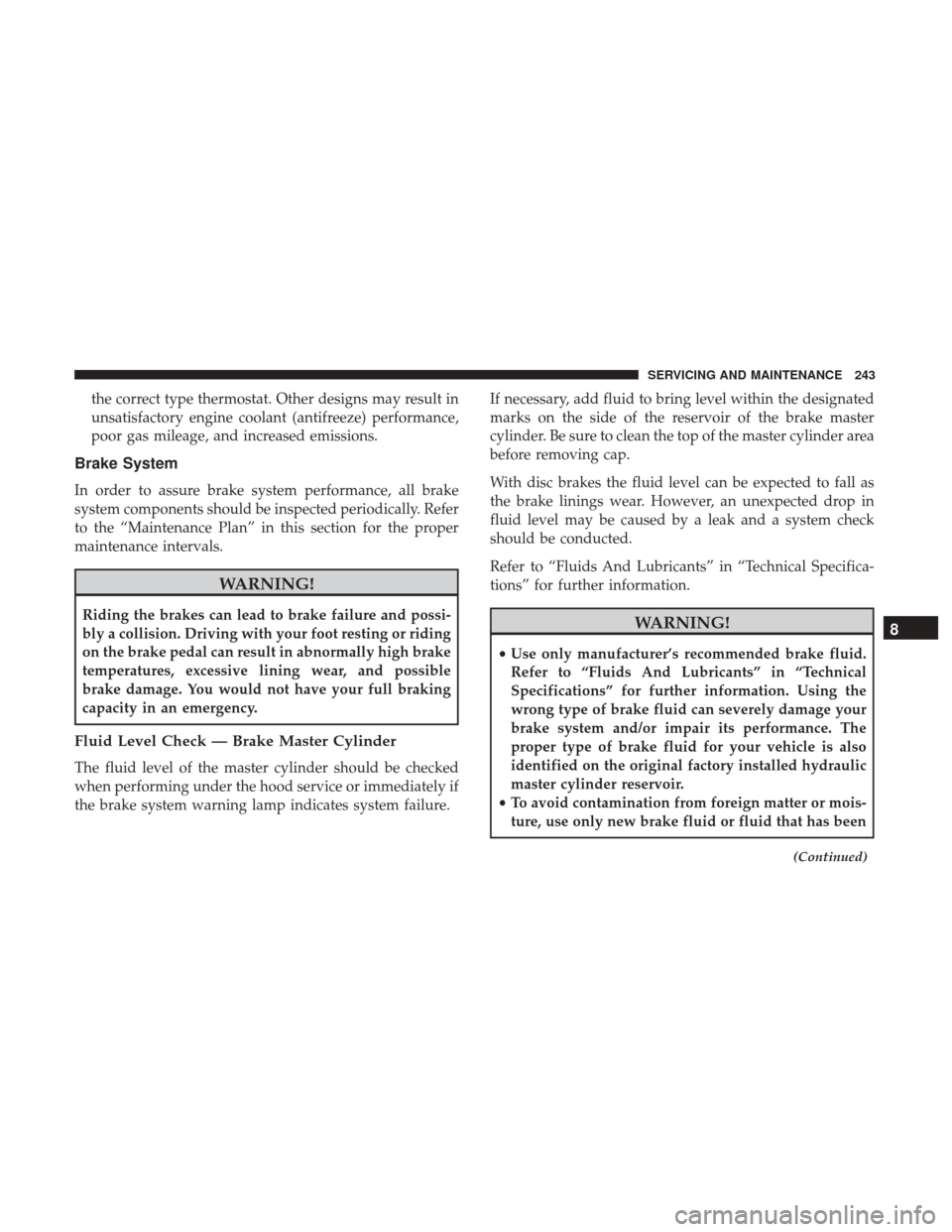
the correct type thermostat. Other designs may result in
unsatisfactory engine coolant (antifreeze) performance,
poor gas mileage, and increased emissions.
Brake System
In order to assure brake system performance, all brake
system components should be inspected periodically. Refer
to the “Maintenance Plan” in this section for the proper
maintenance intervals.
WARNING!
Riding the brakes can lead to brake failure and possi-
bly a collision. Driving with your foot resting or riding
on the brake pedal can result in abnormally high brake
temperatures, excessive lining wear, and possible
brake damage. You would not have your full braking
capacity in an emergency.
Fluid Level Check — Brake Master Cylinder
The fluid level of the master cylinder should be checked
when performing under the hood service or immediately if
the brake system warning lamp indicates system failure.If necessary, add fluid to bring level within the designated
marks on the side of the reservoir of the brake master
cylinder. Be sure to clean the top of the master cylinder area
before removing cap.
With disc brakes the fluid level can be expected to fall as
the brake linings wear. However, an unexpected drop in
fluid level may be caused by a leak and a system check
should be conducted.
Refer to “Fluids And Lubricants” in “Technical Specifica-
tions” for further information.
WARNING!
•
Use only manufacturer’s recommended brake fluid.
Refer to “Fluids And Lubricants” in “Technical
Specifications” for further information. Using the
wrong type of brake fluid can severely damage your
brake system and/or impair its performance. The
proper type of brake fluid for your vehicle is also
identified on the original factory installed hydraulic
master cylinder reservoir.
• To avoid contamination from foreign matter or mois-
ture, use only new brake fluid or fluid that has been
(Continued)
8
SERVICING AND MAINTENANCE 243
Page 284 of 332
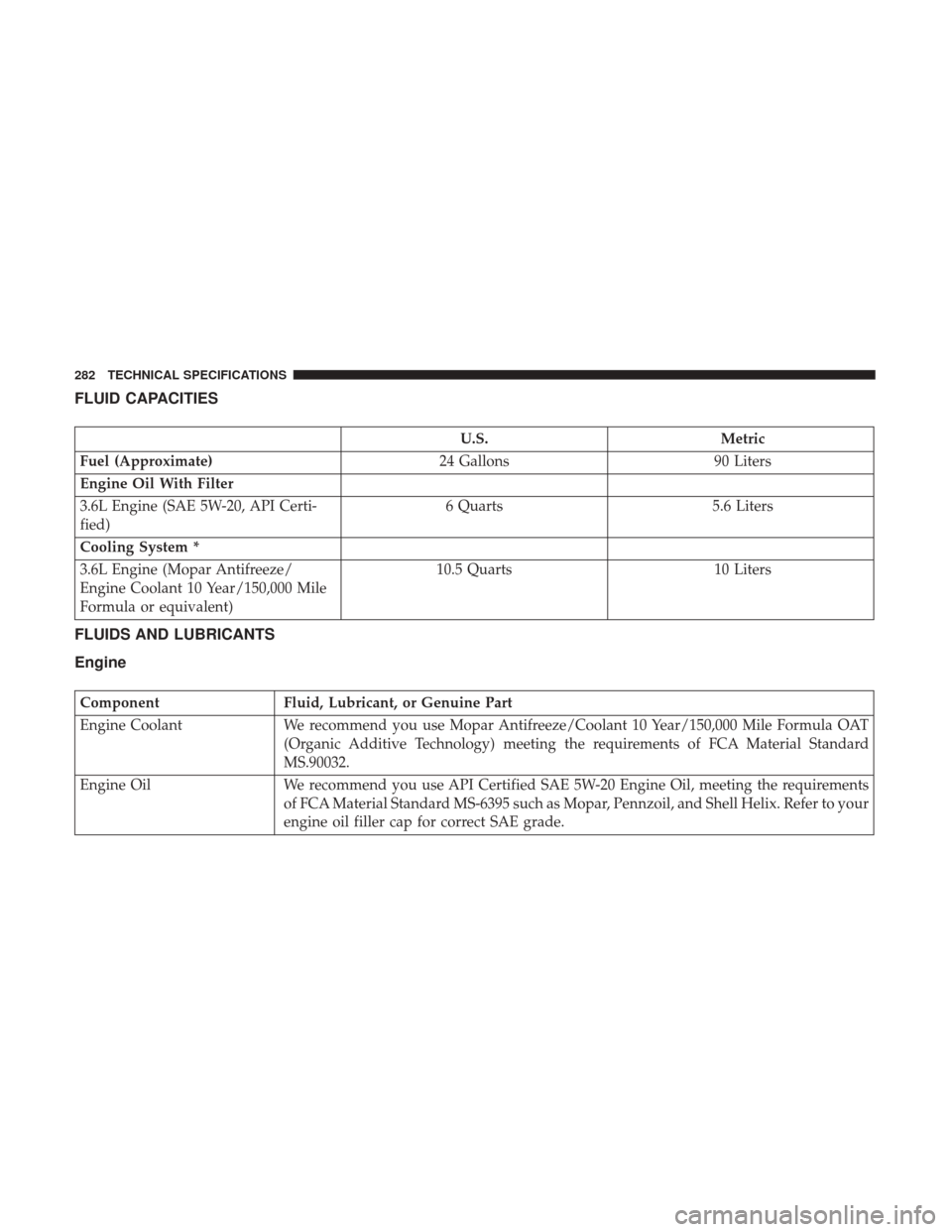
FLUID CAPACITIES
U.S.Metric
Fuel (Approximate) 24 Gallons90 Liters
Engine Oil With Filter
3.6L Engine (SAE 5W-20, API Certi-
fied) 6 Quarts
5.6 Liters
Cooling System *
3.6L Engine (Mopar Antifreeze/
Engine Coolant 10 Year/150,000 Mile
Formula or equivalent) 10.5 Quarts
10 Liters
FLUIDS AND LUBRICANTS
Engine
ComponentFluid, Lubricant, or Genuine Part
Engine Coolant We recommend you use Mopar Antifreeze/Coolant 10 Year/150,000 Mile Formula OAT
(Organic Additive Technology) meeting the requirements of FCA Material Standard
MS.90032.
Engine Oil We recommend you use API Certified SAE 5W-20 Engine Oil, meeting the requirements
of FCA Material Standard MS-6395 such as Mopar, Pennzoil, and Shell Helix. Refer to your
engine oil filler cap for correct SAE grade.
282 TECHNICAL SPECIFICATIONS
Page 285 of 332
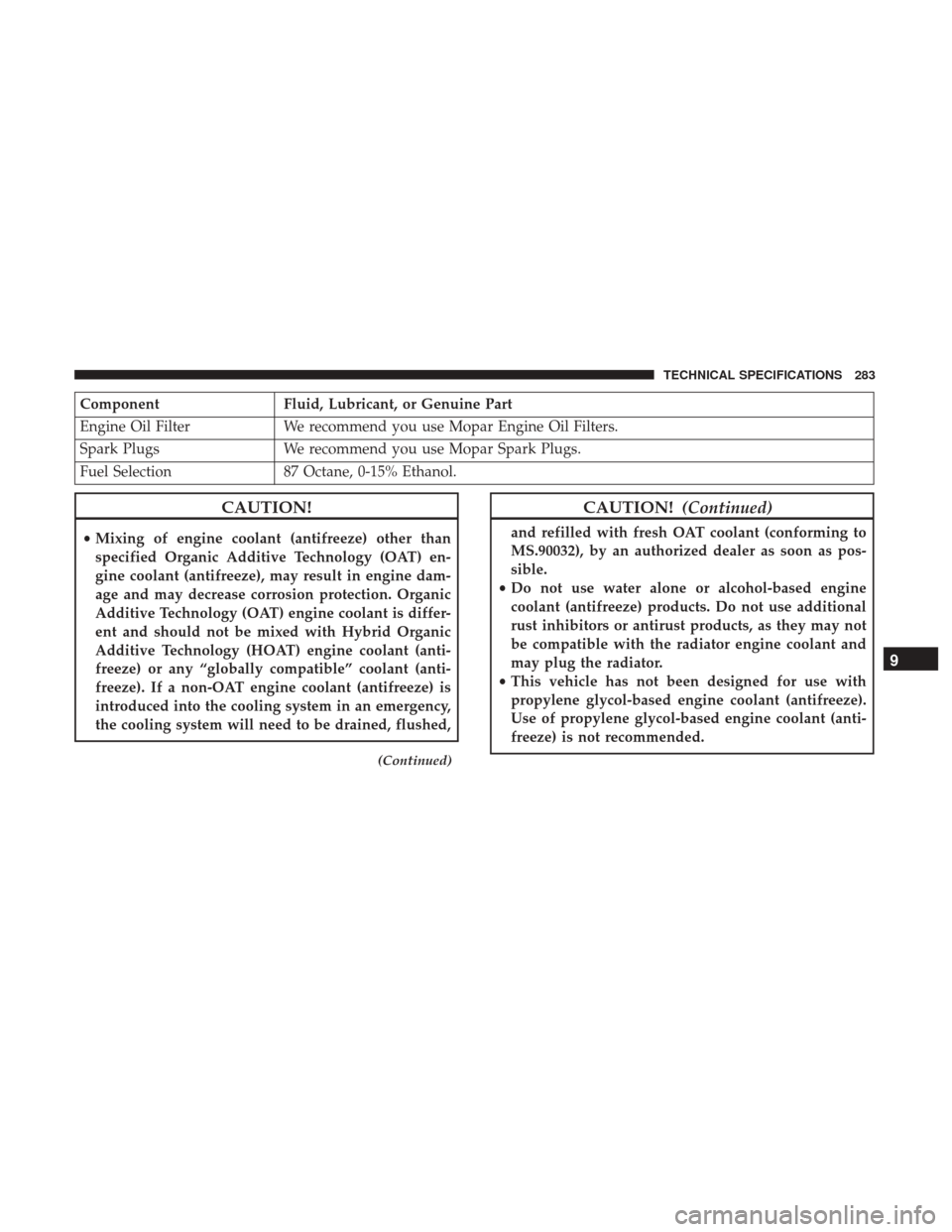
ComponentFluid, Lubricant, or Genuine Part
Engine Oil Filter We recommend you use Mopar Engine Oil Filters.
Spark Plugs We recommend you use Mopar Spark Plugs.
Fuel Selection 87 Octane, 0-15% Ethanol.
CAUTION!
•Mixing of engine coolant (antifreeze) other than
specified Organic Additive Technology (OAT) en-
gine coolant (antifreeze), may result in engine dam-
age and may decrease corrosion protection. Organic
Additive Technology (OAT) engine coolant is differ-
ent and should not be mixed with Hybrid Organic
Additive Technology (HOAT) engine coolant (anti-
freeze) or any “globally compatible” coolant (anti-
freeze). If a non-OAT engine coolant (antifreeze) is
introduced into the cooling system in an emergency,
the cooling system will need to be drained, flushed,
(Continued)
CAUTION! (Continued)
and refilled with fresh OAT coolant (conforming to
MS.90032), by an authorized dealer as soon as pos-
sible.
• Do not use water alone or alcohol-based engine
coolant (antifreeze) products. Do not use additional
rust inhibitors or antirust products, as they may not
be compatible with the radiator engine coolant and
may plug the radiator.
• This vehicle has not been designed for use with
propylene glycol-based engine coolant (antifreeze).
Use of propylene glycol-based engine coolant (anti-
freeze) is not recommended.
9
TECHNICAL SPECIFICATIONS 283
Page 318 of 332
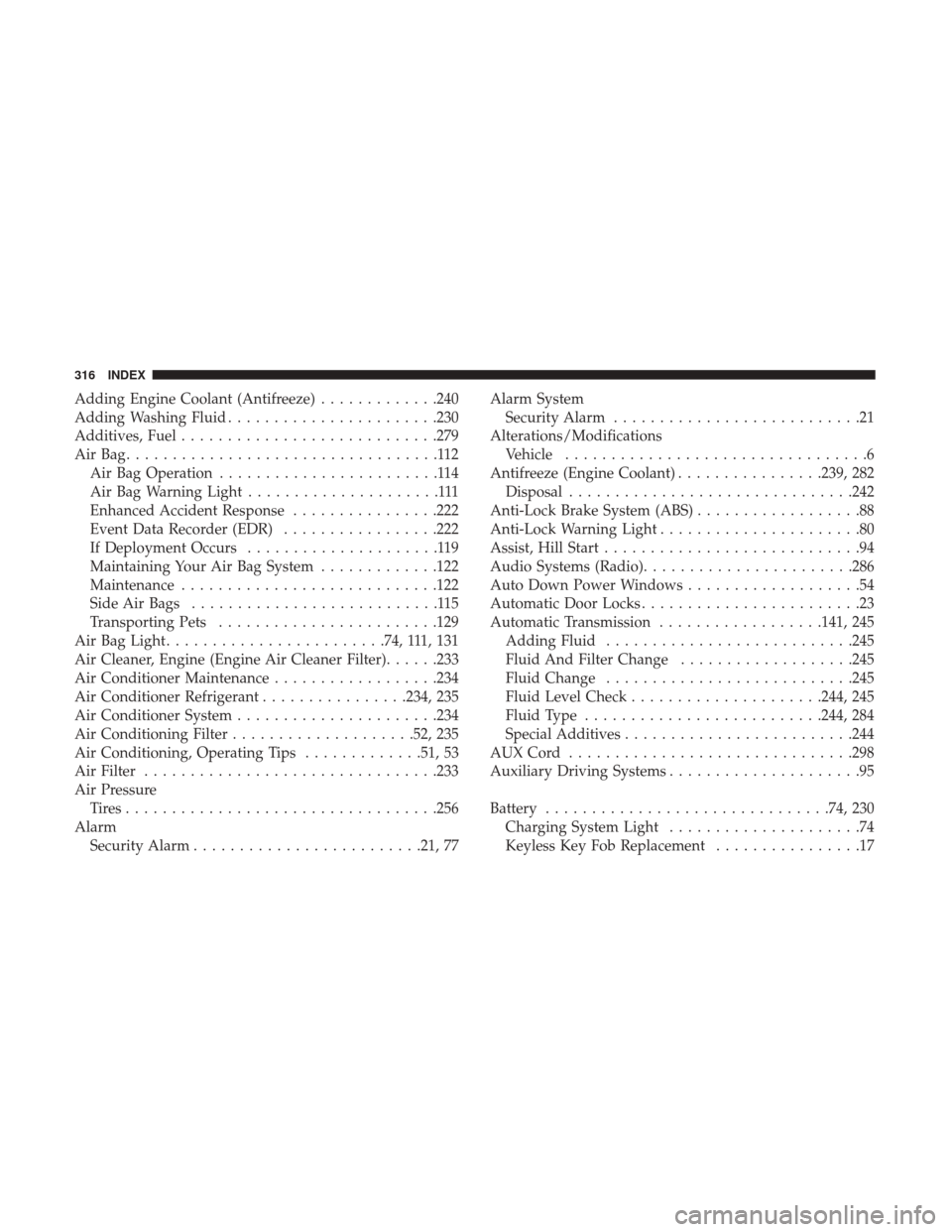
Adding Engine Coolant (Antifreeze).............240
Adding Washing Fluid ...................... .230
Additives, Fuel ........................... .279
AirBag..................................112 Air Bag Operation ........................114
Air Bag Warning Light .....................111
Enhanced Accident Response ................222
Event Data Recorder (EDR) .................222
If Deployment Occurs .....................119
Maintaining Your Air Bag System .............122
Maintenance ........................... .122
Side Air Bags ...........................115
Transporting Pets ....................... .129
Air Bag Light ....................... .74, 111, 131
Air Cleaner, Engine (Engine Air Cleaner Filter) ......233
Air Conditioner Maintenance ..................234
Air Conditioner Refrigerant ................234, 235
Air Conditioner System ..................... .234
Air Conditioning Filter ....................52, 235
Air Conditioning, Operating Tips .............51, 53
Air Filter ............................... .233
Air Pressure Tires................................. .256
Alarm Security Alarm ........................ .21, 77Alarm System
Security Alarm ...........................21
Alterations/Modifications Vehicle .................................6
Antifreeze (Engine Coolant) ................239, 282
Disposal .............................. .242
Anti-Lock Brake System (ABS) ..................88
Anti-Lock Warning Light ......................80
Assist, Hill Start ............................94
Audio Systems (Radio) ...................... .286
Auto Down Power Windows ...................54
Automatic Door Locks ........................23
Automatic Transmission ..................141, 245
Adding Fluid .......................... .245
Fluid And Filter Change ...................245
Fluid Change .......................... .245
Fluid Level Check .....................244,
245
Fluid Type ......................... .244, 284
Special Additives ........................ .244
AUXCord .............................. .298
Auxiliary Driving Systems .....................95
Battery .............................. .74, 230
Charging System Light .....................74
Keyless Key Fob Replacement ................17
316 INDEX
Page 319 of 332
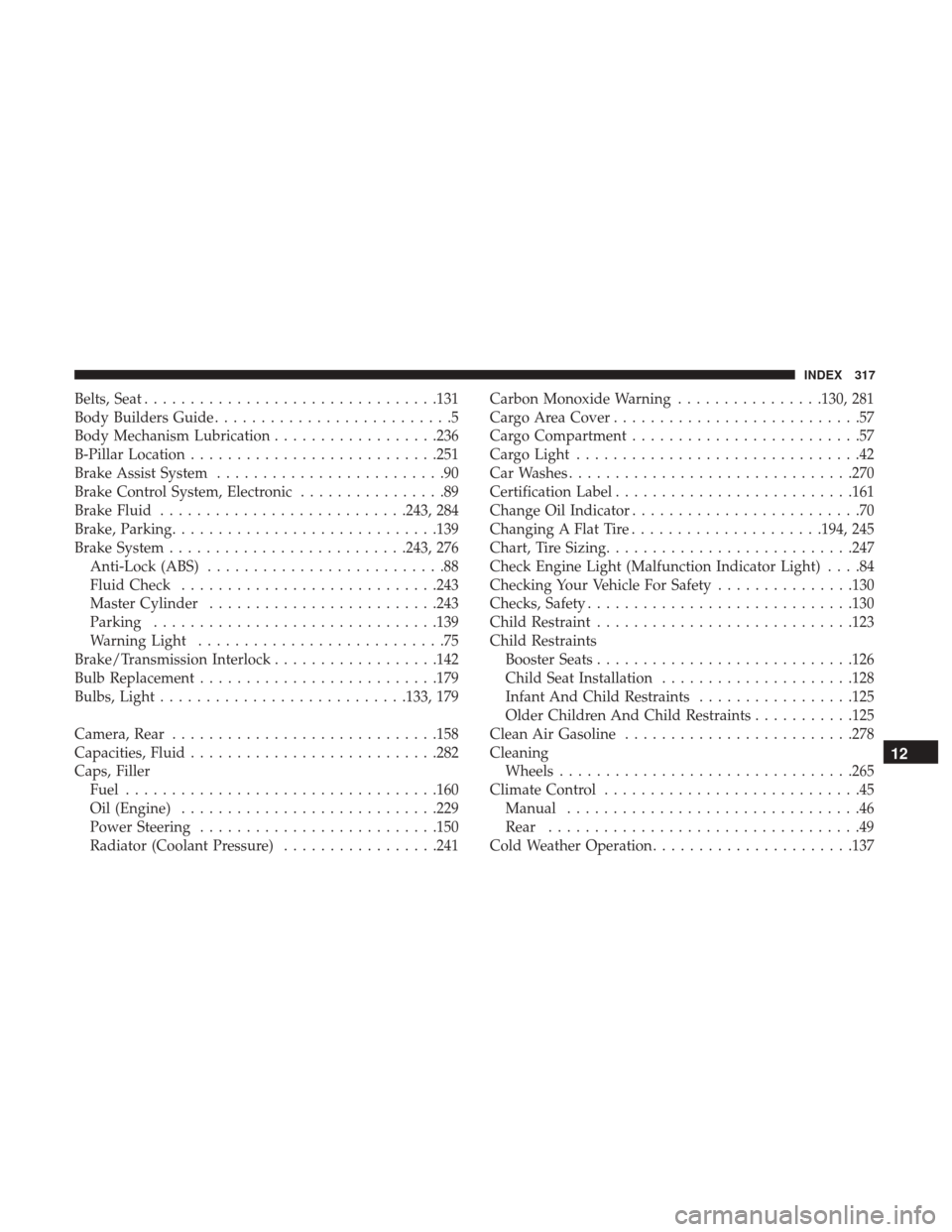
Belts, Seat............................... .131
Body Builders Guide ..........................5
Body Mechanism Lubrication ..................236
B-Pillar Location .......................... .251
Brake Assist System .........................90
Brake Control System, Electronic ................89
Brake Fluid .......................... .243, 284
Brake, Parking ............................ .139
Brake System ......................... .243, 276
Anti-Lock (ABS) ..........................88
Fluid Check ........................... .243
Master Cylinder ........................ .243
Parking .............................. .139
Warning Light ...........................75
Brake/Transmission Interlock ..................142
Bulb Replacement ......................... .179
Bulbs, Light .......................... .133, 179
Camera, Rear ............................ .158
Capacities, Fluid .......................... .282
Caps, Filler Fuel ................................. .160
Oil (Engine) ........................... .229
Power Steering ......................... .150
Radiator (Coolant Pressure) .................241 Carbon Monoxide Warning
................130, 281
Cargo Area Cover ...........................57
Cargo Compartment .........................57
Cargo Light ...............................42
Car Washes .............................. .270
Certification Label ......................... .161
Change Oil Indicator .........................70
Changing A Flat Tire .....................194, 245
Chart, Tire Sizing .......................... .247
Check Engine Light (Malfunction Indicator Light) ....84
Checking Your Vehicle For Safety ...............130
Checks, Safety ............................ .130
Child Restraint ........................... .123
Child Restraints Booster Seats ........................... .126
Child
Seat Installation .....................128
Infant And Child Restraints .................125
Older Children And Child Restraints ...........125
Clean Air Gasoline ........................ .278
Cleaning Wheels ............................... .265
Climate Control ............................45
Manual ................................46
Rear ..................................49
Cold Weather Operation ..................... .137
12
INDEX 317
Page 320 of 332
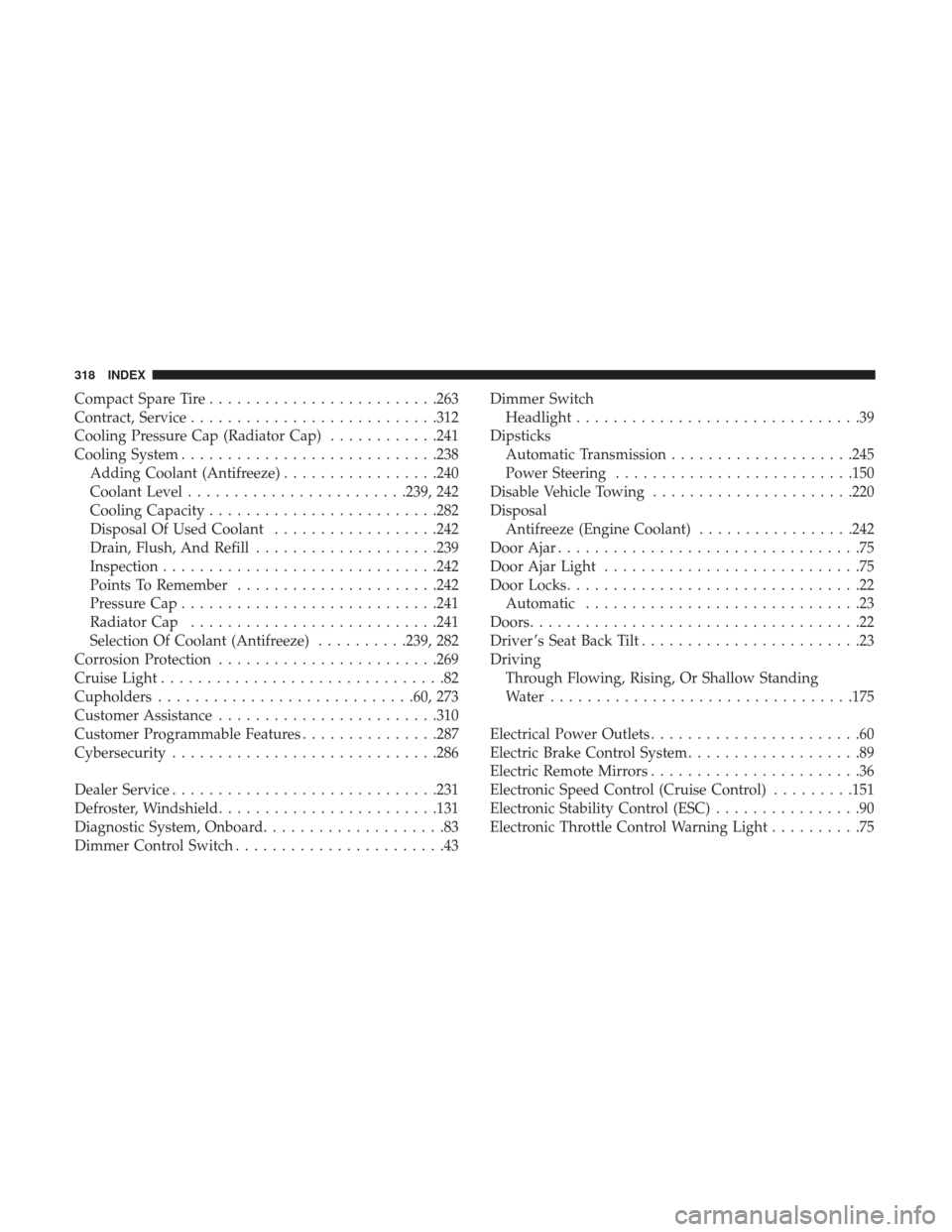
Compact Spare Tire........................ .263
Contract, Service .......................... .312
Cooling Pressure Cap (Radiator Cap) ............241
Cooling System ........................... .238
Adding Coolant (Antifreeze) .................240
Coolant Level ....................... .239, 242
Cooling Capacity ........................ .282
Disposal Of Used Coolant ..................242
Drain, Flush, And Refill ....................239
Inspection ............................. .242
Points To Remember ..................... .242
Pressure Cap ........................... .241
Radiator Cap .......................... .241
Selection Of Coolant (Antifreeze) ..........239, 282
Corrosion Protection ....................... .269
Cruise Light ...............................82
Cupholders ........................... .60, 273
Customer Assistance ....................... .310
Customer Programmable Features ...............287
Cybersecurity ............................ .286
Dealer Service ............................ .231
Defroster, Windshield ....................... .131
Diagnostic System, Onboard ....................83
Dimmer Control Switch .......................43 Dimmer Switch
Headlight ...............................39
Dipsticks Automatic Transmission ....................245
Power Steering ......................... .150
Disable Vehicle Towing ..................... .220
Disposal Antifreeze (Engine Coolant) .................242
Door Ajar .................................75
Door Ajar Light ............................75
Door Locks ................................22
Automatic ..............................23
Doors ....................................22
Driver ’s Seat Back Tilt ........................23
Driving Through Flowing, Rising, Or Shallow Standing
Water ................................ .175
Electrical
Power Outlets .......................60
Electric Brake Control System ...................89
Electric Remote Mirrors .......................36
Electronic Speed Control (Cruise Control) .........151
Electronic Stability Control (ESC) ................90
Electronic Throttle Control Warning Light ..........75
318 INDEX